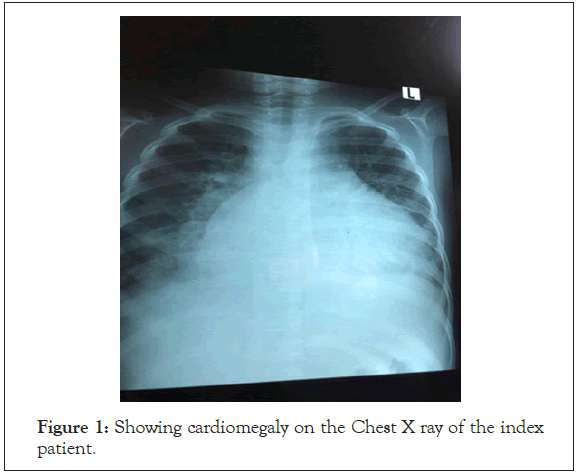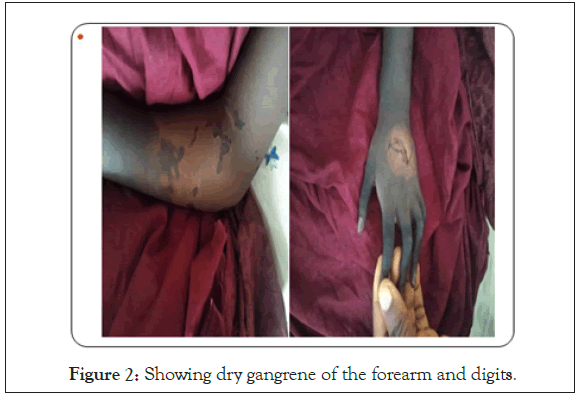Clinical & Experimental Cardiology
Open Access
ISSN: 2155-9880
ISSN: 2155-9880
Case Report - (2021)Volume 12, Issue 5
Gangrene from left ventricular thrombus secondary to severe left ventricular dysfunction, is a very rare disease seen in children with cardiac disease.
ON is a 6-year-old male who presented with a progressively worsening difficulty in breathing, progressively worsening facial, abdominal and leg swellings. Salient findings on examination were tender hepatomegaly, tachycardia (Pulse Rate (PR)=106 bpm) hypotension Blood Pressure (BP)=80/60 mmHg and displaced apex.
Positive findings on investigation revealed ST and Q waves abnormalities and inverted T waves on ECG, Dilated Cardiomyopathy (DCM) with pericardial effusion and left ventricular ejection fraction of 21% on echocardiography. Patient was commenced on intranasal oxygen and anti-failure regimen. He improved remarkably as evidence by improvement in clinical and echocardiographic indices.
Three days later a bluish discoloration of the left hand was noted. This progressed to form dark patchy macules, cold extremities and severe pain in the fingers with absent radial pulse and grade zero power.
Echocardiography; Hypotension; Cardiothoracic unit
Gangrene from left ventricular thrombus secondary to severe left ventricular ejection fraction especially if it less than 35%, is a very rare disease seen in children with cardiac disease [1]. Ischaemic gangrene from cardiomyopathy or any cardiac lesion usually arise from development of left ventricular thrombus [2].
The pathophysiology of thrombus leading to ischaemic gangrene has been attributed to endothelial injury, hypercoagulability, and blood stagnation, known as Virchow’s triad [3,4]. Predisposing factors could range from large thrombus in the heart and severe myocardial ischaemic changes [4]. We present a rare case of gangrene in a child arising from complications of cardiomyopathy. This is the first time of seeing this case over several decades.
ON is a 6-year-old male who presented with a progressively worsening difficulty in breathing, progressively worsening facial, abdominal and leg swellings. No history of sore throat, joint pain or reduced urine output. Salient findings on examination were tender hepatomegaly, tachycardia (PR=106 bpm) hypotension BP=80/60 mmHg and displaced apex. Urine flow rate was 2mil/kg/hr.
Positive findings on investigation revealed ST and Q waves abnormalities and inverted T waves on ECG, dilated cardiomyopathy (DCM) with pericardial effusion and left ventricular ejection fraction of 21% on echocardiography. Serum electrolyte, urea and creatinine and urinalysis were normal. Initial diagnosis of heart failure secondary to cardiomyopathy was made.
Patient was commenced on intranasal oxygen, intravenousdobutamine, intravenousfurosemide, tabs spironolactone, digoxin, enalapril, vasoprin.
Patient condition remained the same until 3 days into admission when a bluish discoloration of the left hand was noted (Figures 1 and 2). This progressed to form dark patchy macules, cold extremities, and severe pain in the fingers with absent radial pulse and grade zero power.

Figure 1: Showing cardiomegaly on the Chest X ray of the index patient.

Figure 2: Showing dry gangrene of the forearm and digits.
An additional diagnosis of dry gangrene of the left hand secondary to thromboembolism was made. Patient was reviewed by Cardiothoracic Unit (CTU), orthopedic surgeon, hematologist, pain and palliative specialists.
Doppler ultrasound done at this point showed thrombosed brachial and forearm arteries. Parents were counseled for below-elbow amputation but they refused to give consent. He was commenced on subcutaneous clexane and oral antibiotics.
Presently child’s condition has improved but the left hand has remained the same. Child was subsequently discharged following parent’s request but has continued on medications at discharge.
Hutchison in 1891 first described ischaemic gangrene in a 37-year-old male who developed gangrene of fingers, toes and ear aftershock [5]. This phenomenon causes a very high mortality of about 40% in the general population. Furthermore, over 50% of children who survive often need amputation of the affected limb [6]. Our patient wasplanned for amputation of the affected hand and digit but this did not hold.
Gangrene is a rare syndrome with overall literature citing less than 100 cases [7]. This is the first time over several decades of seeing this case in our centre. It is important to note that the loss of an extremity may pose an irreparable and colossal threat to the psychological, social and physical functioning of the patient. This could cause attendant socioeconomic problems arising from amputation [8]. These may have contributed to the reluctance of the parents.
There is no age or gender limit to the development of gangrene [9]. A very high index of suspicion is therefore paramount in diagnosis. The first sign of vascular ischemia changes could be mild pyrexia with marked cold extremities, cyanosis and severe pain with little or no motion in the affected limbs. The index patient was in excruciating pain with cold extremities and very small pulse volume.
In very extreme cases, there could be auto amputation [10]. Amputation is the treatment of choice, the use of anticoagulant like clexin, antibiotics and anti-shock regimen was used in the index patient to at least resolve the cardiac failure.
Gangrene in children with cardiomyopathy is a very rare and uncommon anomaly which often results in amputation of the affected limb. Early recognition and vigorous treatment of the underlying cause may avert this lethal sequel.
We declare that we have no competing interests.
This study was not funded by any organization.
Informed consent was obtained from the parent of the child.
EO and JMC contributed to the conception, writing and proof reading of this manuscript. FU, VO and IA contributed in reading and editing the manuscript.
Citation: Chinawa J, Ujunwa F, Agu G, Arodiwe I, Obidike E (2021) Ischemic Gangrene in a Child with Dilated Cardiomyopathy. J Clin Exp Cardiolog. 12:680.
Received: 03-May-2021 Accepted: 17-May-2021 Published: 24-May-2021 , DOI: 10.35248/2155-9880.21.12.680
Copyright: © 2021 Chinawa J, et al. This is an open-access article distributed under the terms of the Creative Commons Attribution License, which permits unrestricted use, distribution, and reproduction in any medium, provided the original author and source are credited.